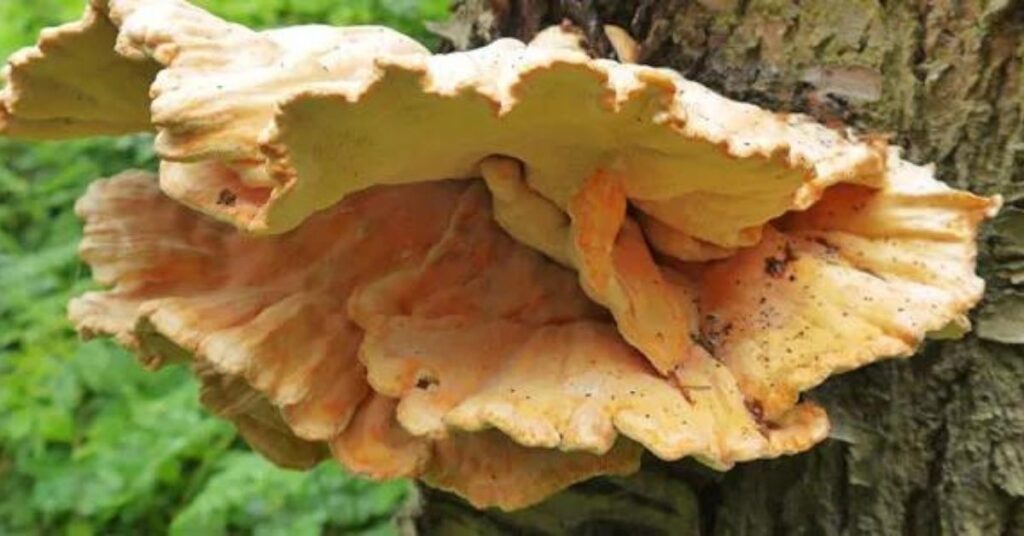Chicken of the Woods, scientifically known as Laetiporus, is a unique and flavorful wild mushroom that has been enjoyed by foragers and food enthusiasts for centuries. Originating from various parts of the world, this mushroom has gained popularity for its distinct appearance, culinary versatility, and potential health benefits.
Identification and Characteristics
Chicken of the Woods mushrooms are easily identifiable by their vibrant colors and shelf-like appearance. They typically grow in overlapping clusters, with bright yellow to orange caps and creamy white undersides. The texture is often described as tender and chicken-like, hence the name. These mushrooms thrive on the decaying wood of both hardwood and coniferous trees, making them a common sight in forests and wooded areas.
Edibility and Culinary Uses
While Chicken of the Woods is generally considered safe for consumption, it’s essential to properly identify the mushroom and avoid any potential lookalikes. Young specimens are preferred for their tender texture and mild flavor, which can range from subtly sweet to slightly tangy. Common cooking methods include sautéing, grilling, or incorporating them into soups, stews, and stir-fries. They are also prized for their ability to mimic the taste and texture of chicken, making them a popular choice for vegetarian and vegan dishes.
Nutritional Value
Chicken of the Woods mushrooms are not only delicious but also packed with essential nutrients. They are low in calories and fat while providing a good source of protein, fiber, vitamins, and minerals. These mushrooms contain notable amounts of potassium, vitamin C, vitamin B6, and antioxidants, which may offer various health benefits, including immune support and improved digestion.
Foraging Tips
Foraging for Chicken of the Woods requires careful observation and knowledge of their preferred habitat and growing conditions. They are commonly found on dead or dying trees, particularly oak, beech, and chestnut. It’s crucial to harvest only young, fresh specimens and to avoid mushrooms with signs of decay or contamination. Using a sharp knife, carefully cut the mushrooms from the tree, leaving a portion behind to allow for regrowth.
Preservation Methods
To extend the shelf life of Chicken of the Woods, proper preservation techniques are essential. Fresh mushrooms can be stored in the refrigerator for up to a week, preferably in a paper bag to allow for airflow. Freezing and drying are also effective methods for long-term storage, allowing you to enjoy the flavors of Chicken of the Woods year-round.
Safety Precautions
While Chicken of the Woods is generally safe to eat, it’s essential to exercise caution when foraging for wild mushrooms. Some species may have toxic lookalikes, which can cause illness or even be fatal if ingested. Always consult reliable sources or experienced foragers for guidance on proper identification and safety precautions.
Cultural Significance
Chicken of the Woods mushrooms hold cultural significance in various societies, often featuring in folklore, traditional medicine, and culinary practices. In some cultures, they are believed to possess mystical properties or are revered for their supposed ability to bring good luck and prosperity. Additionally, Chicken of the Woods has been used medicinally for its potential healing properties, although further research is needed to validate these claims.
Environmental Impact
As decomposers, Chicken of the Woods mushrooms play a vital role in ecosystems by breaking down dead wood and recycling nutrients back into the soil. Their presence contributes to the health and balance of forest ecosystems, making them an essential component of biodiversity. However, over-harvesting and habitat loss pose significant threats to wild mushroom populations, highlighting the importance of responsible foraging practices and conservation efforts.
Medical Uses and Research
While research on the medicinal properties of Chicken of the Woods is ongoing, preliminary studies suggest that they may offer potential health benefits. Compounds found in these mushrooms, such as beta-glucans and polysaccharides, have demonstrated antioxidant, anti-inflammatory, and immune-boosting properties in laboratory studies. Further research is needed to explore their therapeutic applications fully.
Common Misconceptions
Despite their popularity, Chicken of the Woods mushrooms are subject to various misconceptions and myths. One common myth is that all wild mushrooms are poisonous, leading to unnecessary fear and avoidance. In reality, many wild mushrooms are edible and delicious when properly identified and prepared. By learning to distinguish between different species and following safety guidelines, foragers can enjoy the bounty of nature safely.
Health Risks and Allergies
While Chicken of the Woods is generally safe for consumption, individuals with allergies to mushrooms should exercise caution. Some people may experience adverse reactions, such as gastrointestinal upset or allergic dermatitis, after consuming mushrooms. It’s essential to start with small portions and monitor for any signs of discomfort or allergic reactions. If in doubt, consult a healthcare professional before consuming wild mushrooms.
Growing Your Own Chicken of the Woods
For those interested in cultivating their own mushrooms, Chicken of the Woods offers an exciting opportunity. While it can be challenging to replicate the exact growing conditions found in the wild, it’s possible to cultivate these mushrooms using specialized techniques. By inoculating logs or substrate with mushroom spawn, enthusiasts can enjoy a sustainable and rewarding harvest right in their own backyard.
Culinary Pairings
Chicken of the Woods mushrooms pair well with a variety of flavors and ingredients, making them a versatile ingredient in the kitchen. Their meaty texture and mild flavor complement a wide range of dishes, including pasta, risotto, omelets, and sandwiches. For a gourmet touch, consider pairing Chicken of the Woods with complementary ingredients such as garlic, herbs, cheese, or wine, to enhance their natural flavors.
Conclusion
Chicken of the Woods mushrooms are a delightful and versatile ingredient that deserves a place in every culinary enthusiast’s repertoire. With their vibrant colors, unique texture, and rich flavor, these wild mushrooms offer endless possibilities for creative cooking and gastronomic exploration. Whether foraged from the forest or cultivated at home, Chicken of the Wood’s continues to captivate our taste buds and inspire culinary innovation.
FAQs (Frequently Asked Questions)
Are Chicken of the Woods mushrooms safe to eat?
Yes, when properly identified and prepared, Chicken of the Wood’s mushrooms are safe for consumption.
Where can I find Chicken of the Wood’s mushrooms?
Look for Chicken of the Wood’s mushrooms in wooded areas, particularly on dead or dying hardwood trees.
Can I cultivate Chicken of the Wood’s mushrooms at home?
Yes, with the right materials and techniques, it’s possible to cultivate Chicken of the Woods mushrooms in your own backyard.
What do Chicken of the Woods mushrooms taste like?
Chicken of the Wood’s mushrooms have a mild, slightly sweet flavor with a tender, meaty texture reminiscent of chicken.
Are there any health benefits to eating Chicken of the Woods mushrooms?
Chicken of the Wood’s mushrooms are nutritious and may offer various health benefits, including immune support and improved digestion.







